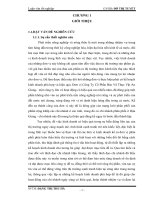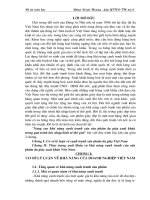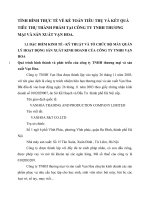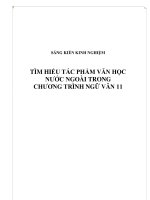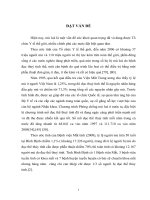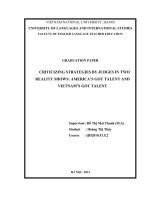CHIẾN LƯỢC ĐƯA RA LỜI BÌNH PHẨM BỞI BAN GIÁM KHẢO TRONG CHƯƠNG TRÌNH TRUYỀN HÌNH THỰC TẾ: TÌM KIẾM TÀI NĂNG MỸ VÀ TÌM KIẾM TÀI NĂNG VIỆT NAM
Bạn đang xem bản rút gọn của tài liệu. Xem và tải ngay bản đầy đủ của tài liệu tại đây (347.34 KB, 81 trang )
VIETNAM NATIONAL UNIVERSITY, HANOI
UNIVERSITY OF LANGUAGES AND INTERNATIONAL STUDIES
FACULTY OF ENGLISH LANGUAGE TEACHER EDUCATION
GRADUATION PAPER
CRITICIZING STRATEGIES BY JUDGES IN TWO
REALITY SHOWS: AMERICA’S GOT TALENT AND
VIETNAM’S GOT TALENT
Supervisor: Đỗ Thị Mai Thanh (M.A)
Student : Hoàng Thị Thủy
Course : QH2010.F1.E2
HÀ NỘI - 2014
ĐẠI HỌC QUỐC GIA HÀ NỘI
TRƯỜNG ĐẠI HỌC NGOẠI NGỮ
KHOA SƯ PHẠM TIẾNG ANH
KHÓA LUẬN TỐT NGHIỆP
CHIẾN LƯỢC ĐƯA RA LỜI BÌNH PHẨM BỞI BAN GIÁM KHẢO
TRONG CHƯƠNG TRÌNH TRUYỀN HÌNH THỰC TẾ: TÌM KIẾM TÀI
NĂNG MỸ VÀ TÌM KIẾM TÀI NĂNG VIỆT NAM
Giáo viên hướng dẫn: Đỗ Thị Mai Thanh (M.A)
Sinhviên : Hoàng Thị Thủy
Khóa : QH2010.F1.E2
HÀ NỘI - 2014
ACCEPTANCE
I hereby state that I: Hoang Thi Thuy (QH2010.F1.E2), being a candidate for
the degree of Bachelor of Arts (TEFL) accept the requirements of the
University relating to the retention and the use of bachelor’s Graduation Paper
deposited in the library.
In terms of these conditions, I agree that the origin of my paper deposited in
the library should be accessible for the purposes of the study and research, in
accordance with the normal conditions established by the librarian for the care,
loan or reproduction of the paper
Signature
Hoang Thi Thuy
ACKNOWLEDGEMENT
I am deeply indebted to a number of people for helping to make this study
possible. First and foremost, I would like to express my deepest gratitude to
my supervisor – Ms Do Thi Mai Thanh (M.A) who supported and encouraged
me generously throughout this research study. Without her guidance and
support, my thesis would not have been possible.
I am greatly indebted to Ms Nguyen Thi Thom Thom (M.A) for her valuable
advice and excellent academic guidance which are decisive factors in the
completion of this thesis.
I would like to sincerely thank all my lectures at University of Languages and
International Studies, Vietnam National University, Hanoi for their profound
knowledge and outstanding teaching.
My appreciation is also extended to my close friends Nguyen Thi Mai Thu and
Bui Thi Nguyet for their kind support and encouragements.
Last but not least, my heartfelt thanks go to my parents, especially my mother
whose support and encouragement did play an important role in the success of
my study
i
ABSTRACT
This study examines the similarities and differences in the application of
giving criticism between the American and Vietnamese judges in two reality
shows: America’s got Talent and Vietnam’s got Talent. The research primarily
focuses on the popularity and preference of employing criticizing strategies by
the two panels.
The research results are based on the collection nine episodes of America’s got
Talent season 6 and Vietnam’s got Talent season 1. The criticizing utterances
employed by American and Vietnam panels were noted down and categorized
into five criticizing strategies.
The results of the research show that criticizing - communicative act - is
performed with a variety of strategies. The study showed some significant
similarities and differences in the choices as well as frequencies of using
criticizing strategies by American and Vietnamese judging panels.
It is hopeful that the research could contribute to the understanding as well as
enhancing American-Vietnamese cultural communicative knowledge and be a
useful source of reference for researchers in the future.
ii
TABLE OF CONTENTS
Acknowledgement……………………………………………………… i
Abstract………………………………………………………………… ii
Table of contents………………………………………………………….iii
List of tables…………………………………………………………… v
List of figures…………………………………………………………… v
PART A: INTRODUCTION…………………………………………….1
1. Statement of research………………………………………………… 1
2. Research aims and research questions…….………………………… 2
3. Significance of the study………………………………………………3
4. Scope of the study…………………………………………………… 3
5. Organization of the study………………………………………………4
PART B: DEVELOPMENT…………………………………………… 5
CHAPTER 1: LITERATURE REVIEW……………………………….5
1.1.Cross-culture communication…………………………………………5
1.1.1. Culture ………………………………………………………….5
1.1.2. Communication…………………………………………………6
1.1.3. Cross-cultural communication………………………………….8
1.2.Criticizing as a communicative act……………………………………9
1.2.1. Criticism…………………………………………………………9
1.2.2. Criticism – a communicative act………………………………10
1.3.Reality show………………………………………………………… 15
1.3.1. Definition……………………………………………………….15
1.3.2. Got Talent……………………………………………………….16
1.3.2.1. Definition of Got Talent…………………………………16
1.3.2.2. Format of Got Talent…………………………………….17
iii
CHAPTER 2: METHODOLOGY…………………………………………18
2.1. Research design………………………………………………………18
2.1.1. Selection of subjects…………………………………………… 18
2.1.2. Participants…………………………………………………… 18
2.1.2.1. American judging panel (season 6 – 2011)……………………19
2.1.2.2. Vietnamese judging panel (season 1 – 2011)………………….19
2.1.3. Data collection procedures…………………………………… 20
2.1.4. Data analysis procedures…………………………………………20
CHAPTER 3: FINDINGS AND DISCUSSION………………………….21
3.1. Results………………………………………………………………… 21
3.1. 1. Result of research question 1…………………………………… 21
3.1.2. Result of research question 2………………………………………28
3.2. Discussion………………………………………………………………36
PART C: CONCLUCISON……………………………………………… 38
1. Summary of the findings……………………………………………… 38
2. Implications…………………………………………………………… 39
3. Limitations of the study…………………………………………………40
4. Suggestions for the further studies…………………………………… 41
REFERENCES…………………………………………………………………42
APPENDICES………………………………………………………………….46
Appendix A: America’s got Talent…………………………………………… 46
Appendix B: Vietnam’s got Talent…………………………………………… 60
LIST OF TABLES AND FIGURES
iv
Table 1.1: Taxonomy of mitigating strategies in criticizing.
Table 3.1: The use of criticizing strategies by two judging panels in America’s
got talent and Vietnam’s got talent
Table 3.2: Use of strategy 1 by American panel and Vietnamese panel
Table 3.3: Use of strategy 2 by American panel and Vietnamese panel
Table 3.3: Use of strategy 3 by American panel and Vietnamese panel
Table 3.4: Use of strategy 4 by American panel and Vietnamese panel
Table 3.5: Use of strategy 5 by American panel and Vietnamese panel
Figure1.1: Diagram of components of communication
Figure 3.1: Use of criticizing strategies by the American panel in American’s got
talent
Figure 3.2: Use of criticizing strategies by the Vietnamese panel in Vietnam’s got
talent
Figure 3.3: Use of criticizing strategies by American judges and Vietnamese
judges in America’s got talent and Vietnamese’s got talent
PART A: INTRODUCTION
1. Statement of research
v
Language is defined as a powerful communication system for human
beings to express thought, ideas as well as forge friendships, cultures among
numerous countries around the world. Therefore, it is can be definitely believed
that language and culture are closely related and interdependent. Language is a
tool to convey culture and culture also reflects language in another way. “Culture
is in language, and language is loaded with culture” (Karen (2008)). Similarly,
this point is shared by Hudson (1981):” As for the relation between language and
culture, most of language is contained within culture”. Hence, different cultures
will have different ways to show their desires, compliments or criticism about one
aspect.
In communication, while giving encouragement plays an important role in
helping people have motivation to continue their work whereas the others- who
are thin-skinned and easily up-set when receiving criticism. According to
Fleishman, he said that “Most of us, swimming against the tides of trouble the
world know nothing about, need only a bit of praise or encouragement- and we
will make the goal”. Encouragement is considered a useful tool for people in any
cases; Winston Churchill stated, “Criticism may not be agreeable, but it is
necessary. It fulfills the same function as pain in the human body. It calls
attention to an unhealthy state of things”. Obviously, the role of criticism is
undeniable. Different culture will have different strategies to give criticism.
Culture shock often happens in cross-cultural interaction when interactants are not
aware of this aspect. Thus, in intercultural communication, raising learners'
awareness of the cultural difference is crucial.
Criticism plays an essential component in terms of reflecting the
fundamental culture and value of a specific country. However, criticism – a
communicative act seems not to be investigated much by linguistics as well as
researchers. There have been some studies regarding the act of criticizing, and the
application of them in academic documents such as “a study on verbal criticism in
English and Vietnamese” (Doan, 2010), “a comparative study of criticism
vi
between American and Vietnamese online newspapers” (Pham, 2008). Yet these
did go insight into analyzing criticism in term of language. Thus, for the
abovementioned reasons, in this study, researcher will focus on America’s got
talent 2011 and Vietnam’s got talent 2011 with the aims of providing the
Vietnamese audiences with a specific look into the differences and similarities in
term of criticizing strategies by judges in these two reality shows. Hopefully, this
study will contribute to cross-cultural communication between America and
Vietnam about giving criticism strategies.
2. Research aims
The study is conducted to investigate the common strategies in giving
criticism on the performances of contestants in America’s got Talent and
Vietnam’s got Talent. In addition, the research will also point out the similarities
as well as the differences in the application of those strategies between American
and Vietnamese judging panels. Besides, the study is carried out with the aim of
helping the Vietnamese audiences be aware of intercultural communication in
giving criticism in a TV reality show.
In order to achieve the purposes stated above, the study revolves around the
following questions:
1. What are common criticizing strategies used by Vietnamese judges, and
what ones are chosen by American judges in Vietnam’s got Talent and America’s
got talent?
2. What are differences and similarities in the application of these strategies
between the American and Vietnamese judges in the two reality shows?
3. Significance of the study
This research investigates strategies in giving criticism in two reality
shows American’s got Talent and Vietnam’s got Talent 2011. It is set to find out
common strategies employed by American judges as well as Vietnamese judges as
vii
well as the similarities and differences in the applications of those. It is hopeful
that the outcome of the study would be a source of reference materials for
teaching English to Vietnamese learners.
In addition, the study can help Vietnamese learners know more about
the differences and similarities in American-Vietnamese cross-cultural
dimensions.
Last but not least, the researcher hopes that this study can provide an
insightful view into criticizing theory for Vietnamese readers.
4. .Scope of the study.
The study focuses on strategies in giving criticism employed by both
American as well as Vietnamese panels. Criticizing is reflected through verbal
and non-verbal communication. However, because of limited knowledge,
materials and time; within this graduation paper, the researcher desires to examine
verbal criticizing strategies which are popular and familiar with learners.
In addition, to raise learner’s awareness of the application of
criticizing strategies, the data used for illustration and exemplification are taken
mainly from nine episodes of two reality shows: America’s got Talent (season 6)
and Vietnam’s got Talent (season 1).
5. Organization of the study
The study consists of three parts and each of which is set to deal with a
specific aim
Part A: Introduction
viii
This part presents overview of the study including statement of the problem
and rationale for the study, research aims and research questions, significance,
scope and the organization of the study.
Part B: Development
Chapter 1: Literature review
In this chapter, the researcher provides the readers with the background of
the study including all the terms as well as the key theoretical concepts and the
discussion of related studies.
Chapter 2: Methodology
This chapter describes the participants and instrument as well as the
procedures to conduct the research.
Chapter 3: Findings and discussion
Chapter 3 presents the results of the study that researcher investigates from
the collected data based on the two research questions. In addition, a detailed
discussion about the employment of the study are provided as well
Part C: Conclusion
In this part, the researcher will summarize the major issues discussed in the
study and point out the limitations as well as propose several suggestions for
further studies
PART B: DEVELOPMENT
CHAPTER 1: LITERATURE REVIEW
1.1. Cross-cultural communication.
1.1.1. Culture
The term “culture” can be considered as the most complicated concept
to define because it consists of numerous definitions and “the definition of culture
ix
remains elusive and contested”. According to Hall (1976, p.16), “Culture is not
genetically inherited, and cannot exist on its own, but is always shared by
members of a society”. In this definition, the researcher tends to emphasize the
association between culture and humans. Moreover, culture is the reflection of
what human beings want as it is a set of “shared and enduring meaning, values,
and beliefs the characterize national, ethnic, or other group and orient their
behavior” (Mulholland, 1991). Hence, culture itself covers all features of human’s
life.
In addition, several researchers also have attempted to define “Culture”
concept by their ways. For instance, Tylor (1874, p.1) points out that “ Culture ,
taken in its wide ethnographic sense, is that complex whole which includes
knowledge, belief, art, morals, law, custom, and any other capabilities and habits
acquired by man as member of society”. While Tylor just provides the audiences
with his general background knowledge about the theory of culture, Lederach
(1995) stated that “Culture is the shared knowledge and schemes created by a set
of people for perceiving, interpreting, expressing, and responding to the social
realities around them”. In other way, culture is “everything that people have, think
or do as a member of a society” (Ferraro, 1998).
To sum up, culture refers to patterns of human’s behaviors, as well as
interactions. In other words, culture is the result of human’s intervention in the
process of socialization. Through those patterns, it can be easily identified or even
distinguished the people in a certain cultural group. Thus, most of those
definitions play important parts in helping the researcher analyze and hypothesize
several aspects in this study.
1.1.2. Communication
x
Communication is absolutely indispensable discipline in human life.
Linguists also try to give different definitions about the term “ communication” in
their own way by basing on the importance of its. As Hybels and Weaver (2001,
p.5) stated, “ any process in which people share information, ideas, and feelings
that involve not only the spoken and written words but also body language,
personal mannerism and style, the surrounding and things that add meaning to a
message”. In other words, communication is the means of transferring messages
through non-verbal and verbal language such as speech, visuals, signals, writing
and behaviors as well.
Similarly, Bach and Harnish (1979) defined communication as “the
exchange and negotiation processes between at least two individuals through the
use of verbal and non-verbal symbols, oral and written/visual modes, and
production and comprehension processes”. It can be inferred that the process of
communicating involves verbal and non-verbal communications as well. The two
kinds of code are referred to as forms of communication. The following diagram
of Nguyen Quang (2002:9) will attain a better view at components of
communication:
xi
Communication
Verbal communication Non-verbal communication
Intralanguage
e
Paralanguage Extralanguage
-Vocabulary
-Grammatical rules
-Phonetic rules
-Rules of language
use
-Vocal characteristics:
pitch, volume, rate, vocal
quality, types of vocal flow
-Vocal inferences
Body language Object language Environmental language
-Eye contact
-Facial expressions
-Gestures
-Postures
-Physical characteristics
-Body movement…
-Clothing
-Jewelry
-Makeup
-Artificial scents
…
-Setting
-Conversational distance
-Time
-Lighting system/color
Figure1.1: Diagram of components of communication
( Nguyen Quang, 2002:9)
The function of communicating is not only to give information to each
other but also to send messages through eye-contact, body language or even tone
of speaker’s voice. Thus, through verbal as well as non-verbal communication,
the speaker can provide the receivers with meaningful message (Levine and
Adelman (1993). Beisler (1997) also has the similar definition about this term,
“communication is the transmission from one person to another of a message
which is understood by the receiver as the sender intended”. In other words, a
message or communication is generally sent by a sender with intended purpose
and receiver as well. Through several opinions about the definition of
communication, it cannot be denied that as long as a person is surrounded by
others, it is inevitable to communicate. Thanks to communicating, message or
information could be sent and those play vital part in the existence of humankind
specifically and the society generally.
1.1.3. Cross-cultural communication
With the process of globalization, especially the increase of global trade,
different cultures will meet conflict and blend together as Hofstede (1991) noted
that culture commonly means “civilization”. In other words, culture includes
normal things in life such as greeting, communication, etc. Hence, people from
different cultures will find it hard to communicate not only due to language
barrier but also because of different communication styles. Thus, cross-cultural
communication has been studied seriously.
According to Kramsch (1998, p.81), cross- cultural communication can be
understood as “the meeting of two cultures or languages across the political
boundaries of nation states”. This is the exchange and negotiation between
xii
individuals coming from different cultures. Sharing the same idea, Levine and
Adelman (1993) believe that “cross-cultural communication is communication
between people from different cultures; communication that is influenced by
cultural values, attitudes and behaviors; the influence of culture on people and
recreations and responses to each other”.
It can be inferred that the term cross cultural communication describes the
ability of communicating and forming relationship with people coming from
different culture. This is based on the knowledge of several factors such as values,
norms, manners and social structure. Thus, it is undoubtedly seen that culture
significantly contributes to one of the biggest challenge for cross-cultural
communication. When languages are distinct, the potential of misunderstanding
will increase without the translation.
It is understandable that culture shapes communication and the way of
interpreting communication. Cross-cultural communication gives members from
different background opportunities to exchange ideas, share information and
experience. However, in order to keep the communication smooth and successful,
people need to be aware of potential problems that may happen during
communicating
1.2.Criticizing as a communicative act
1.2.1. Criticism.
Giving criticism is an art and the giver is the artist, too. According to
Oxford Learner’s Dictionary, criticism is “the act of expressing disapproval of
somebody/something and opinions about their faults or bad qualities; a statement
showing disapproval”. Criticism is considered as something unpleasant because it
is often implied to point the faults of someone. Besides the main function of
criticizing, Wajnryb (cited in Hoang (2007, p.144) stated, “Criticism may provide
a rich, timely potentially fruitful opportunity for learning”. When the speaker
finds that a performance of the candidate is unsatisfactory, he/she has to decide to
give the act of criticism with the aim of bringing the most suitable advice for the
xiii
contestants. Hence, learners enable to realize their weak points and improve them
in appropriate ways. Similarly, Collins Cobuild Advanced Learner’s English
Dictionary (2006) defined, “criticizing is an act of making fair, careful judgments
about the good and bad qualities of someone or somebody”. For instance “Thank
you for your report. I can see you put a lot of effort in it. However I was hoping
you could touch it up a little by summarizing it more carefully and adding some
graphs. This content is solid, but if you could make those small changes, I would
appreciate it” (Pham, 2011, p.12)
Therefore, coming to such decisions of giving criticism, speakers need to
know the appropriate time to produce the speech act. Basically, there are
constructive and destructive criticisms. Constructive criticism is the process of
offering valid and well-reasoned opinions about someone or something, usually
involving both positive and negative comments, in a friendly manner rather than
an opposite one. In collaborative work, this kind of criticism is often a valuable
tool in raising and maintaining performance standards. Destructive criticism is
intended to “harm someone, derogate and destroy someone’s creation, prestige,
reputation and self-esteem”.( Oxford Learner’s Dictionary)
It can be denied that criticism could be positive or negative,
maintain or threat the communicator’s face; however, criticism can be the
fundamental reflection of the society’s value; therefore, the study of criticism can
be a key attribute of providing the audiences with crucial information about social
norms as well as values embedded in culture.
1.2.2. Criticism – a communicative act
When producing an utterance, the speaker usually assigns a meaning for the
communicative purpose. As an act of communication, that purpose succeeds if the
xiv
audience identifies, in accordance with the speaker’s intention, the attitude being
expressed. John Austin (1962) put the first foundation on the existence of speech
act and up to now, numerous linguists such as John Searle (1969), Searle (1979)
inherits Austin’s ideas and elaborates on several aspects of Austin’s notion.
Speech act theory has been commented upon and become a source of
inspiration for many linguistic theorists. One of them is Habermas, who has taken
Searl’s theory as the starting for the development of his product called “Theory of
communicative action”. Habermas (1984, p.85-101) defined, “Communicative
action is individual action designed to promote common understanding in a group
and to promote cooperation, as opposed to strategic action designed simply to
achieve one’s personal goals”. It can be inferred that communicative actions as
the interaction of social actors pursuing goals by achieving shared understanding
and coordinating their plans of action. In Haberman’s theory, the illocutionary act
is not related to grammatical forms as it is in Searle’s theory. In that case, the
illocutionary effect depends on the language function. According to Habermas,
there are three major types of language functions: constatives – while saying
something, the speaker refers to the objective world, regulative – related to the
social world and expressive – when the speaker refers to her/his own subjective
experience. As Habermas (1984, p.94) states: “Achieving understanding in
language is…introduced as a mechanism for coordinating action”. An essential
requirement for successful communication action is the “satisfaction of the
conditions determined by the ideal speech situation” (Cooke, 1997, p.33).
Criticising is seen as a communicative act with the communicative purpose
as showing “disapproval of somebody or something” (Oxford Learner’s
Dictionary). Some researchers have investigated the relationship between
communication and criticism (Christensen & Heavey, 1990). Criticism is the most
significant factor of the expressed emotion index (Hooley & Teasdale, 1989). A
criticism can be realized by either direct or indirect strategies. Following Blum-
Kulla (1987), the directness level of a criticism was determined by the degree of
xv
illocutionary transparency, and thus the amount of effort needed to interpret the
illocutionary point of this criticism. Meanwhile, “The more indirect the mode of
realization, the higher will be interpretive demands (Blum – Kulka, 1987:133)
In addition, Wajnrub (1993) holds “an effective criticism must be kept
simple specific, well-grounded, linked to strategies for improvement and
delivered as an attempt to share experience. It also needs to be softened by means
of a number of strategies. These include ‘measuring words’ (to avoid being too
negative), ‘soft-pedaling’ (i.e. using internal and external modifications to lessen
the harshness of the criticism), ‘using affirmative language’ such as comforting
messages, ‘distancing and neutralizing’ (to depersonalize the criticism) and ‘using
negotiating language’ (to avoid imposing on the addressee.) (Wajnryb, 1993; cited
by Nguyen, 2003: 15)
For example, a criticism can be mitigated by different type of formulae.
Table 1 presents taxonomy of mitigating strategies from Nguyen (2003, p.236):
xvi
Type
1 Direct
criticism
Characteristics
Explicitly poiting out the problem
with hearer’s choice/actions/work,
etc.
Examples
a.Negative
evaluation
b Expression
of disagreement
c Statement of
the problem
d Statement of
difficulty
e.
Consequences
Usually expressed via evaluative
adjectives with negative meaning or
evaluative adjective with positive
meaning plus negation.
Usually realized by means of
negation word “No” or performatives
“I don’t agree” or” I disagree” or via
arguments against hearer.
Stating errors or problems found with
hearer’s choice.
Usually expressed by means of such
structures as “I find it difficult to
understand…”, “it’s difficult to
understand ”
Warning about the negative
consequences or negative effects of
the hearer’s choice.
“I think it’s not a good
way to support to one’s
idea, “Umm that’s not
really a good sentence”
“I don’t quite agree with
you with some points.”
“And there are some
incorrect words”
“You had a few
mistakes”
“ I can’t understand”, “I
find it difficult to
understand your idea”
“Someone who doesn’t
agree with you would
straight away read that
and turn off
2 Indirect
criticism
a Demand for
change
Implying the problems with hearer’s
choice/actions/work, etc. by
correcting hearer giving advice,
suggesting or even requesting and
demanding changes to hearer’s
work/choice, and by means of
different kinds of hints to raise
hearer’s awareness of the
inappropriateness of hearer’s choice.
“You have to talk about
your opinion in your
summary”
xvii
b Advice about
change
c Asking
questions.
d. Expression
of uncertainty
e. Other hints
Usually expressed via structure as
“you have to”, “you must”, “it is
necessary”.
Usually expressed via the
performative “ I advise you…” or
structures with “should”
Rhetorical questions to raise hearer’s
awareness of the inappropriateness of
her/his choice, etc
Utterances expressing speaker’s
uncertainty to raise the hearer’s
awareness of the inappropriate of the
hearer’s choices, etc.
Including other kinds of hinds and
may include sarcasm, exaggerations.
“You should change it a
little bit”
“Did you read your
writing again after you
finish it?”
“Are there several
paragraphs ah not sure
about the paragraphs
“ I prefer a writing style
which are not too
personal”
Table 1.1: Taxonomy of mitigating strategies in criticizing.
( Nguyen Thi Thuy Minh, 2003:236)
Generally, reality shows have been investigated by many researchers such
as Hua (2013), Pham (2011) and Tran (2011). When mentioning reality
televisions, there will be numerous aspects for researchers to research, for
instance the performances of the contestants or strategies in commenting as well
as giving encouragements to the candidates’ presentations.
In the context of Vietnam, especially at the University of Languages and
International Studies, many researchers are fond of these topics and as a result a
lot of studies have been carried out.
Pham (2011) and Tran (2011) had the same research topics on reality shows
which were about commenting strategies on the contestants’ performances
employed by judges in America and Vietnam. Hua (2013) developed another
aspect of commenting. The researcher focused on encouraging strategies on the
presentations of candidates in the Voice. In three aforementioned researches,
researchers concentrated on the aspects of commenting, encouragement or even
xviii
compliments; however, this graduation paper will be carried out by researching
the different topic – criticism. The researcher finds out the study of Nguyen
(2003) consisting of many features about criticism which can be useful for the
research. The researcher will make use and adapt several terms mentioned in
Nguyen’s taxonomy of mitigating strategies in criticizing.
1.3. Reality show
1.3.1. Definition.
For the past several years, reality television has dominated “mainstream
television programming, providing relatively inexpensive entertainment” (Gardyn,
2001). Nowadays, reality show is considered as a kind of entertainment which
makes people feel like they are in the real situation. This is becoming more and
more developed and as a result, “reality television saw an explosion of global
popularity starting in the summer of 2000” (Hua, 2013, p.17)
According to Collins Cobuild Advanced Learner’s English Dictionary,
reality show is a “type of television programming that aims to show how ordinary
people behave in everyday life, or in situations, often created by programme
makers, which are intended to present everyday life”. Similarly, Hill (2005) stated
“reality television or a television programming genre that presents purportedly
unscripted melodramatic or humorous situations, document actual events, and
usually features ordinary people instead of professional actors, sometimes in a
contest or other situation where a prize is award”.
It can be inferred that the function of a reality show is to feature talent
culled from the ranks of ordinary people, not professionally trained actors. In
addition, reality shows offer the chance for a renewed interest in those normal
people.
xix
Reality show typically does not have a script, so participants taking part
in those will be put directly in a real situation and act. Everything will be
reflected by the performances of the candidates, and the winner of the show will
depend on the content of each program such as the voting of the audience, given
marks from judges.
1.3.2. Got Talent
1.3.2.1. Definition
Got Talent is a talent show television format conceived and owned by
Simon Cowell’s SYCOtv company. Got Talent is created from British invention
by Simon Cowell with Paul O’Grady – a comedian and the host of talk show ITV.
After the show’s initial success in America, Got Talent has been known and
become popular all over the world. Numerous countries adapt the format of this
reality show and begin to apply into their countries as well. Vietnam is one of
those countries adapting successfully the structure of Got Talent.
1.3.2.2. Format description of American’s got Talent (2011) and
Vietnam’s got Talent (2011)
The format of America’s got Talent is primarily based on the global British
Got Talent franchise. The selection process of the show consists of three main
periods: Producers’ auditions, Judges’ auditions and live shows. In the first
period, the audition will be held in various cities with the aim of choosing the
appropriate candidates. Following the producers’ auditions, the above candidates
will perform their special abilities in front of four celebrity judges. The judges
terminate the candidate’s act by pressing their red buzzer and if the candidate
receives X from all of the judges, they have to stop their performance. In contrast,
receiving three or more “yes” votes from the judges, the candidate definitely goes
xx
to the next round. Finally, during the live shows, a group of candidates’
performances from Top 20 will compete by the number of voting from viewers as
well as judges. The more voted candidates, the more will be chosen into Top 10.
All of the candidates in Top 10 continue performing the best of their abilities and
waiting for public vote. The candidate with the most votes will be the winner.
In this chapter, the researcher has provided the basic theoretical
background to the study issue, including the definitions and concerning
knowledge of certain key concepts as well. This chapter is presented to help the
readers orientate themselves to the content of the research. Thus, researcher can
find out significant results through this chapter and her chosen materials.
CHAPTER 2: METHODOLOGY
2.1. Research design
2.1.1. Selection of subjects
In this research, the developed approach was triangulation which has recently
been applied widely by a lot of researchers. Triangulation approach, is known as a
mixing design which contains “the combination of two or more theories, data sources,
methods or investigators in one study of a single phenomenon to converge on a single
construct, and can be employed in both quantitative (validation) and qualitative
(inquiry) studies” (Yeasmin & Rahman, 2012, p.156). Since quantitative and
qualitative approach have their own limitations, there is mounting evidence shown that
mixing these two types of methods can contribute to a better understanding of the
problems rather than either approach alone (Greene & Caracelli, 1997).
Qualitative approach was applied as one of the main methods in this research.
As a widely-used research design, it “focuses on discovering and understanding the
experiences, perspectives, and thoughts of participants” (Harwell, 2011, p.148). To be
more specific, the researcher will collect, watch and analyze criticizing strategies
employed by the two judging panels in nine episodes of the two reality shows.
xxi
Quantitative research method attempts to maximize objectivity, replicability,
and generalizibility of findings (Michael, 2011, p.149). After analyzing criticizing
strategies, the researcher will calculate the frequency of using those communicative
acts.
The researcher will carry out the study by choosing nine episodes of
America’s got Talent 2011 and Vietnam’s got Talent 2011 including episode 1
( Judges’ auditions), episode 2 (judges’ auditions), episode 6 (judges’ auditions),
episode 7 (judges’ auditions), episode 8 (judges’ auditions), episode 9 (judges’
auditions), episode 10 (judges’ auditions), episode 11 (judges’ auditions) and
episode 14 (quarter finals 1) As for Vietnam’s got Talent 2011, researcher also
choose nine episodes consisting of episode 1 (judges’ auditions called “Vong loai
san khau”), episode 2, episode 4, episode 5, episode 6, episode 7, the 2
nd
semi-
final, the 5
th
semi-final and the 6th semi-final.
Television and the Internet are the great sources for researcher to
investigate as well as analyze her related study. Youtube channel, the official
website of America’s got Talent (America’s got talentauditions.com) and
Vietnam’s got Talent (Vietnamgottalent.vtv.vn) can help researcher complete the
study as well. The chosen episodes from researcher are considered typical ones in
the show in terms of format and content. In addition, they are basic data that
contribute to the success as well as the reliability of the research.
2.1.2. Participants
2.1.2.1. American judging panel (season 6-2011)
Judges Personal information
1.
Howie Mandel
(born November 29,
1955)
a comedian, actor, television host, and voice
actor
2.
Sharon Rachel
Osbourne
( born 9 October 1952)
A television host, media
personality, television talent competition judge,
author, music manager, businesswoman,
xxii
